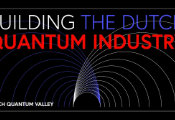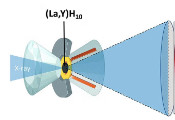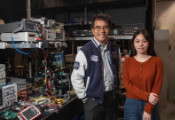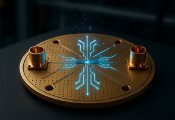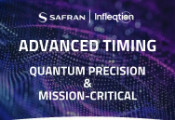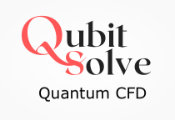US Department of Energy National Quantum Information Science Research Centers Celebrate 4-Year Milestone, Look Toward Future
December 12, 2024 -- Since their establishment in 2020, the five U.S. Department of Energy National Quantum Information Science Research Centers. or NQISRCs, have been expanding the frontier of what’s possible in quantum computing, communication, sensing and materials in ways that will advance basic science for energy, security, communication and logistics. The centers have strengthened the national quantum information science. or QIS, ecosystem, achieving scientific and technological breakthroughs as well as training the next-generation quantum workforce.
“The NQISRCs have developed and leveraged world-class quantum research facilities and instrumentation at the DOE national laboratories and across the national QIS ecosystem. By developing and drawing on these resources, the centers connect industry and academic partners with powerful tools found nowhere else in the world, creating bridges across companies, universities and national labs,” said SQMS Director Anna Grassellino.
Led by a DOE national laboratory, each center comprises a collaborative team spanning a broad range of scientific and engineering disciplines. Bringing together national laboratories, universities and tech companies, the centers have developed into a strong community by creating bridges between the world’s top experts in multiple scientific and technological fields. This further enables researchers to solve major cross-cutting challenges in QIS.
Together, they unite more than 1,500 experts across 115 institutions in North America and Europe. The five centers are:
- Co-design Center for Quantum Advantage (C2QA) led by Brookhaven National Laboratory
- Q-NEXT, led by Argonne National Laboratory
- Quantum Science Center (QSC) led by Oak Ridge National Laboratory
- Quantum Systems Accelerator (QSA) led by Lawrence Berkeley National Laboratory
- Superconducting Quantum Materials and Systems Center (SQMS) led by Fermi National Accelerator Laboratory
“The strength of the National QIS Research Centers lies in their center-scale approach, drawing on the capabilities of our national labs, industry partners and university collaborators to drive breakthroughs in quantum information science and to translate them into technologies that will have meaningful, real-world impacts in our everyday lives,” said Q-NEXT Director David Awschalom.
In their four years of growth and operation, the NQISRCs have achieved multiple successes in QIS and technology:
- Advanced the fundamental science and understanding of the physics behind quantum devices.
- Enhanced quantum devices, the building blocks of quantum computers and sensors, to record performance levels through innovative materials science.
- Built and deployed new quantum processors and sensors at DOE national labs, universities and industry partners.
- Tailored and designed algorithms to efficiently process data on novel quantum devices while exploring commercial quantum platforms and evaluating the computational capabilities of different hardware at DOE’s quantum testbeds.
- Built unique, cutting-edge facilities and instrumentation to characterize, measure, integrate and use quantum devices, processors and sensors.
- Trained more than 1,000 students and early-career researchers through summer schools, internships and research experiences at facilities affiliated with the centers.
- Launched the U.S. Quantum Information Science Summer School, the first of its kind to facilitate an interconnected quantum ecosystem across academia, national labs and industry to train and grow a quantum-ready workforce.
- Connected over 1,600 job seekers with hiring managers from national labs, academia and industry at the virtual Quantum Information Science Career Fair.
- Unveiled nqisrc.org, a centralized digital home for the five centers. The site outlines the NQISRCs’ scientific accomplishments, research developments, workforce opportunities, and educational and scientific resources.
The Quantum Thin Film and Characterization Lab at Oak Ridge National Laboratory where QSC researchers combine molecular beam epitaxy for quantum thin film and heterostructure synthesis with characterization tools to better understand materials at the level of atoms and electrons. This lab is central to the QSC’s efforts to develop quantum material platforms for quantum computing and sensing applications. In this image, Matthew Brahlek, Robert Moore and Qiangsheng Lu are developing topological superconducting materials for quantum computing applications in support of the Quantum Science Center headquartered at ORNL. Credit: Carlos Jones/ORNL, U.S. Dept. of Energy
“Our integrated research programs are transitioning fundamental discoveries in materials and computing to new quantum technologies and their applications,” said QSC Director Travis Humble.
In fall 2024, 200 experts from the five centers met to review four years of progress and discuss an expanded vision for the future of QIS. The event fostered collaboration and strengthened cross-center partnerships.
By bringing quantum technologies to a broader set of researchers and users, the centers are fulfilling DOE’s mission to advance science for the benefit of society.
“The DOE National QIS Research Centers continue to facilitate the transfer of technology, knowledge, and skills from national laboratories and universities to the marketplace, working in a coordinated effort to prepare the U.S. workforce and industry to harness quantum computing’s potential,” said QSA Director Bert de Jong.
The five NQISRCs have grown into a unique and well-connected network of experts and facilities, which together will be critical to advancing the burgeoning field of QIS in the years ahead.
Commenting on the successes of the NQISRCs, the Department of Energy’s Deputy Director of Science Programs Harriet Kung said, “As we mark four years of extraordinary progress, the five National Quantum Information Science Research Centers are not only continuing to push the boundaries of quantum information science but are building a robust ecosystem that spans academia, national labs and industry. Their groundbreaking work in quantum computing, sensing, communication and materials is shaping the future of technology, security and workforce development in ways that will benefit society and meet DOE’s mission to advance science for the public good.”
“The NQISRCs leverage existing talent and expertise from academia, industry, and national labs to accelerate QIS breakthroughs that will advance DOE science. Equally important, they are committed to making QIS more accessible to students, early-career researchers and historically underrepresented groups in STEM. Through their outreach initiatives, the centers are ensuring a robust and diverse workforce for future QIS endeavors,” said C2QA Director Andrew Houck.
The Superconducting Quantum Materials and Systems Center at Fermilab is supported by the DOE Office of Science.

